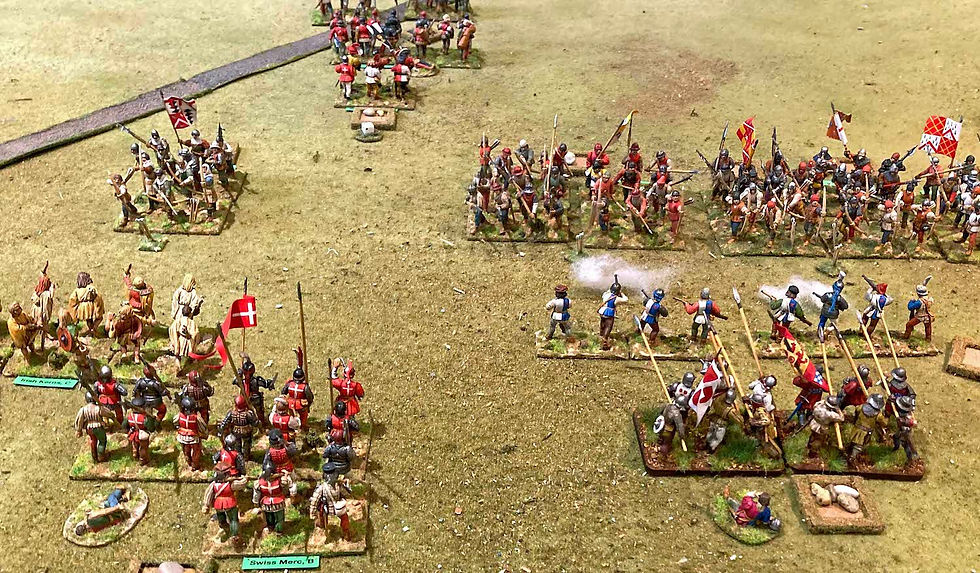Stoke Field (1487) is a most unusual and interesting battle, and the last engagement of the Wars of the Roses.
After Bosworth the 10 year old Lambert Simnel was proclaimed King Edward VI in Dublin with the support of the Earl of Lincoln, Viscount Lovell and the Irish nobility. Bolstered by a large Irish contingent and mercenaries provided by the Duchess of Burgundy, the Yorkists sailed to England to contest the throne with King Henry VII.

My table layout was loosely based on that provided by the Battlefields’ Trust with helpful input from players who had walked the battlefield. The Yorkists are deploying on high ground (left of photo). East Stoke and its enclosures are in the distance.

The veteran Earl of Oxford commanded the vanguard of the Tudor army, supported by Lord Scales’ cavalry wing (in the distance). King Henry VII and Lord Stanley are following on behind (off table). At the outset Oxford had about 6000 men to the Yorkist’s 8000.

The Earl of Lincoln commanded the relatively small English contingent on the Yorkist right.

Martin Schwartz commanded the Swiss, German and Burgundian mercenaries in the centre.

The Yorkist left was held by Sir Thomas Fitzgerald’s Irish.

Many of his light infantry kerns moved into the cover provided by East Stoke’s enclosures to winkle their way around the Tudor right.

Knowing that enemy reinforcements were on their way, the Yorkist players decided on an all-out attack with the intention of defeating Oxford’s vanguard before he could be reinforced.

With far fewer archers, the Yorkist’s began to take casualties as they advanced into the enemy arrow storm. Support from the Burgundian guns on the high ground did little to even the odds.

Lincoln’s contingent overlapped the Tudor left and suffered fewer casualties from archery than the pikemen in the centre. The Earl led his men at arms to charge Sir Gilbert Talbot’s retainers on the end of the Tudor line. The odds were in his favour and he was certain to turn the enemy flank. Then disaster struck. The Earl of Lincoln was killed in the fighting and his men began to lose heart and fall into disarray.

In the centre the Swiss and German pikemen were also wavering due to significant archery casualties. Martin Schwartz decided he needed to attack with his men at arms who were in relatively good order. Supported by artillery and some archery he crashed into Sir Richard Neville’s contingent and threw them back in disorder.

Despite Schwartz’ breakthrough, his pikemen were too badly shot-up to exploit his success.

On the Tudor right, a die roll determined that Lord Scales would vacillate rather than obey his orders to attack. As the Irish advanced against him, he finally finished his stirrup cup and led his wing forward in a charge.The Gallowglass easily saw off the light horse and held the mounted men at arms. Then once again disaster befell the Yorkists. Sir Thomas Fitzgerald was wounded and captured.

In the follow-on melée Scales’ cavalry had the upper hand. This gave them the opportunity to execute Fitzgerald. Leaderless, the Irish began to flee the field only to be cut down by the victorious horsemen.

It was looking pretty grim for the Yorkist cause but worse was to come. King Henry VII arrived on table with reinforcements on the Tudor left. The King immediately charged into the remnants of Lincoln’s contingent and sent them fleeing.

In the centre, the Earl of Oxford led his men against the few remaining Yorkist mercenaries and swept them from the field.
Much like the historical battle, the game was a comprehensive Tudor victory more or less won by Oxford’s vanguard alone. The Yorkists had some bad luck — especially when it came to leader casualties. What really did for them was the Tudor arrow storm which decimated the mercenary pikemen before they had any chance of closing into combat.

Lambert Simnel (formerly known as King Edward VI) is now honing his cooking skills for a career in the Tudor kitchens. Martin Schwartz will no doubt be on the next boat to the continent to collect his pay or to seek service elsewhere. As to the English and Irish survivors on the Yorkist side — very few are likely to be seen again.
The game was played using Tree of Battles rules. I shall endeavour to post the game scenario with full orders of battle before too long on the Scenario section of my website.
HI Simon
what a wonderful looking battle ,the terrain is excellent and the figures extremely well painted .It is a pity that history repeated it self.I look for ward to you posting the scenario and once again thank you for sharing .
Tim O' Connor
I think once again 'Tree of Battle' worked very well as a ruleset to capture the interaction between the different weapon systems and troop-types of this period, whilst also giving a fun game. If the Yorkist commanders hadn't been so unlucky on the day, I think Henry would have had a much tougher fight to retain his crown, with the possibility that the game could have swung the other way.
lovely stuff Simon. The battle report is great and the figures + layout superb
Simon, it looks superb and I'm sure it was an exciting game, glad you all enjoyed yourselves - with the possible exception of whoever was playing Lincoln and Fitzgerald, of course 😅
I wish I could have been there, but duty called elsewhere - enough said. At least it wasn't me rolling the dreaded Dice of Death, for once! 🤣
Ernie